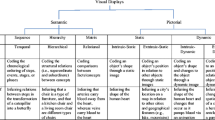Abstract
Whether we know it or not, the environment teaches children how to read. The symbols, pictures, and print in our classrooms are a foundation for later reading. Children need useful and practical information communicated through visual messages.
Similar content being viewed by others
References
Chafel, J. (1982, May/June). Making early literacy a natural happening.Childhood Education, 58 300–304.
Roser, N. L. & Jensen, J. M. (1978, November/December). Real communication — Key to early reading and writing.Childhood Education, 55 90–93.
Schickedanz, J. (1978, September). You be the doctor and I'll be sick: Preschoolers learn the language arts through play.Language Arts, 55 713–718.
Additional information
Sandra L. Gordon and Beth C. Anderson are Associate Professors in the Education Department at Moorhead State University in Minnesota.
Rights and permissions
About this article
Cite this article
Gordon, S.L., Anderson, B.C. Visual messages: Making sense with young children. Early Childhood Educ J 14, 32–33 (1986). https://doi.org/10.1007/BF01620803
Issue Date:
DOI: https://doi.org/10.1007/BF01620803




